In a previous article, I looked at using ESPN’s Hitter Tracker and demonstrated its Ballpark Overlay Tool, which is an easy way to visually compare the dimensions of two ballparks. This is great for getting an idea of which offenses may be in a good position and you can use it to see whether home runs hit at one ballpark would make it over the wall at another, but it’s still a bit general.
What if you want to know very specifically how an individual player’s power translates to another park in a road game? You can use the Ballpark Overlay as I described and compare that with the player’s spray chart, but the truth is, that can be time consuming and inaccurate. Fortunately, Hitter Tracker provides another tool that is better for this type of thing.
There is a way to superimpose a ballpark’s dimensions over a player’s profile to see exactly how many home runs he would have lost had all of his games been played in a particular park. For example, we all know that Joc Pederson has been on a ridiculous heater to start 2015, but he’d probably just be on a “walking barefoot through a large blacktop parking lot on a hot August afternoon” level heater rather than a supernova level heater if he played all of his games in AT&T Park:
On this same page, there’s also a ridiculous amount of information on each home run, if it was lucky, why it was lucky, how many MLB parks the home run most likely would have made it over the fence in, etc. Here’s that section for Joc:
Without this I might have been a little skeptical that around a quarter of Joc’s home runs were hit at Coors Field, but under the “# Parks” category, we can see these would have been home runs anywhere. The other column that I think is important here, for DFS purposes anyway, is the Type/Luck column. ND stands for “No Doubter”, JE is “Just Enough”, and PL is “Plenty” which basically means anything that doesn’t fall into the first two categories.
You also have the ability to use the ballpark overlays on pitchers to see whether they would have saved any home runs by playing in a particular park. Here’s Kyle Kendrick (used 2014 stats on this one) saving a few home runs, and making several others close calls, by playing every game in Nationals Park:
In fact, by looking at his additional info table, I can see that five of the home runs Kendrick allowed in 2014 would have been home runs in less than half of MLB ball parks. There was even one that was hit in the only ballpark in the MLB where it would have been a home run that Garrett Jones just snuck over the wall in Philly and was helped by 27 mile per hour winds.
So this is all interesting and if you’re not careful, you can waste a couple of hours just running different simulations, like I just did – “Hmm, how many home runs would James Shields have saved if he played every game in the Tokyo Dome?” (one, it turns out.) In order to be useful for DFS purposes though, I think the Hitter Tracker is a perfect auxiliary resource to be used with projection tools (and if you’ve made it here, you’re already using a really good projection tool!) For example, you could create a trend that matches players where the wind is blowing to a certain field, or look for players above X percentile in ISO and then run the overlays, and I think that starts to become a very powerful combination.
A note about the Hitter Tracker site, it was designed very, um, interestingly, so it’s not immediately obvious how to do what I just did above (at least for me, it wasn’t.) Here’s how to do it:
- Click on “Main Page” at http://www.hittrackeronline.com/.
- Select “Hitter Team” in drop-down menu.
- Find player you’re clicking for and click on their name under the “Hitter” column
- Select “Overlay Ballpark” on the next page. The additional info is listed below the image.








